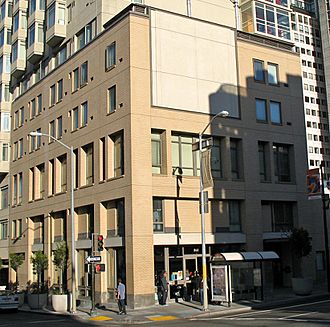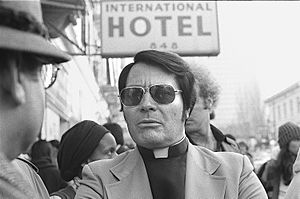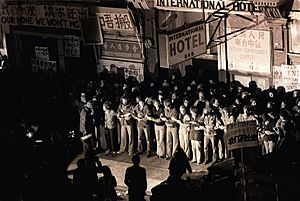International Hotel (San Francisco) facts for kids
Quick facts for kids International Hotel |
|
|---|---|

The 2nd incarnation of the International Hotel
|
|
| Alternative names | I-Hotel |
| General information | |
| Architectural style | Contemporary |
| Town or city | San Francisco, California |
| Coordinates | 37°47′46″N 122°24′17″W / 37.7961°N 122.4048°W |
| Completed | 1954 |
| Relocated | 848 Kearny Street (1873) |
| Renovated | 1907, 2005 |
| NRHP reference No. | 77000333 |
| Added to NRHP | June 15, 1977 |
The International Hotel, often called the I-Hotel, was a special building in San Francisco, California. It offered small, affordable rooms for people with low incomes. Many Asian Americans, especially Filipino Americans, lived there. In the 1950s, a famous nightclub called "hungry i" was even in its basement!
In the late 1960s, big companies wanted to tear down the hotel. This would force all the older people living there to leave their homes. But the tenants, along with activists, students, and community members, decided to fight back. They protested and tried to stop the evictions. Sadly, all the tenants were forced out on August 4, 1977. The hotel was torn down in 1981. Years later, a new building was built on the same spot. It opened in 2005 and now provides homes for seniors. It also shares space with a school and a community center.
Contents
The I-Hotel's Story
Early Days of the Hotel
The I-Hotel first opened in 1854 as a fancy place for travelers. It moved to Kearny Street in 1873. After the big San Francisco Earthquake and Fire in 1906, it was rebuilt in 1907.
In the 1920s and 1930s, many Asian workers who traveled for jobs came to live at the I-Hotel. The area around the hotel grew into a lively Filipino American neighborhood. This 10-block area along Kearny Street became known as Manilatown. In the 1960s, people could rent a room at the I-Hotel for less than $50 a month.
Changes in the City
In the mid-1960s, cities started "urban renewal" projects. This meant tearing down older buildings to build new ones. The goal was to make downtown areas bigger. This movement had already destroyed parts of San Francisco, forcing many families from their homes.
The International Hotel was chosen for demolition. In 1968, a real estate company called Milton Meyer & Co. sent eviction notices to the tenants. They planned to tear down the I-Hotel and build a parking garage. This project would also destroy ten blocks of homes, restaurants, shops, and other Filipino community businesses.
In 1973, a company from Thailand, Four Seas Investment Corporation, bought the I-Hotel. They also wanted to replace it with a more profitable building.
Fighting for Homes
After the first eviction notices in 1968, a long struggle began. People fought in the streets, in court, and in their daily lives.
In 1969, tenants and activists successfully got a longer lease from Milton Meyer & Co. To help pay for this, Asian American art groups and other businesses moved into the hotel's basement. But in 1974, Four Seas Investment Corporation sent new eviction notices. This made the community organizers plan new ways to resist.
Many people helped organize the protests. Community poet Al Robles was a key leader. The head of the International Hotel Tenant Association, Emil deGuzman, and tenants Wahat Tampao and Felix Ayson also played big roles. Ed Lee, who later became mayor, volunteered as an attorney. He worked on legal agreements to stop the evictions.
Students from nearby University of California, Berkeley and San Francisco State University also joined. They helped repair and repaint the I-Hotel. This made sure it stayed livable, even when the Four Seas Investment Corporation stopped maintaining it.
Jim Jones, a leader of the Peoples Temple group, also got involved. He was appointed Chairman of the San Francisco Housing Authority Commission. The Housing Authority then voted to buy the building. They planned to use government money to turn it over to groups that protected tenants' rights.
But a court rejected this plan and ordered the evictions in January 1977. The Peoples Temple brought many people to surround the building. They barricaded the doors and chanted "No, no, no evictions!" The local sheriff, Richard Hongisto, who was an ally of Jones, refused to carry out the eviction order. Because of this, he was held in contempt of court and spent five days in jail.
In the early morning of August 4, 1977, about 400 San Francisco police officers arrived. They began to physically remove tenants from their homes. About 3,000 protesters tried to stop them. Within six hours, all 55 remaining tenants were evicted. In total, 197 tenants had been forced to leave.

The New I-Hotel Community Center
In 1994, a real estate company sold the I-Hotel land to the Roman Catholic Archdiocese of San Francisco. Then, the United States Department of Housing and Urban Development gave an $8.3 million grant. This money was for building new affordable housing. The Chinatown Community Development Center was chosen to manage this project.
Construction on the new I-Hotel began in 2003. The building was finished on August 26, 2005. The new building has 105 apartments for senior citizens. A lottery was held to decide who would live there. The people who had lived in the original I-Hotel were given first choice. People started moving in during October 2005.
The new building also has a community center on the ground floor. There is a historical display that tells the story of the original I-Hotel. A new mural on the building shows pictures of activists like Al Robles, Etta Moon, and Bill Sorro. It reminds everyone of their fight to keep affordable housing in San Francisco.



